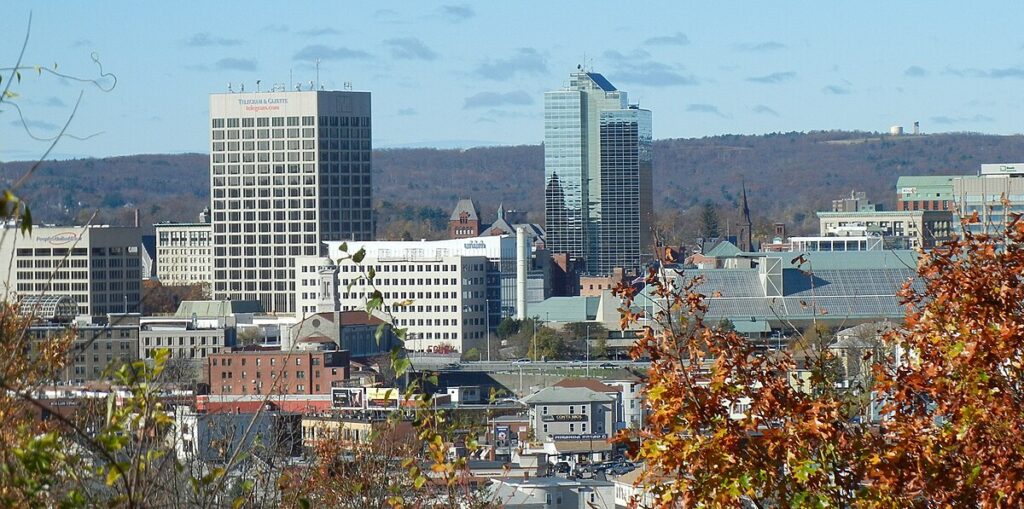
Moving to Worcester, Massachusetts: A Comprehensive Relocation Guide
Considering moving to Worcester, Massachusetts? This historic city offers affordable living, healthcare excellence, and revival energy. With approximately 206,000 residents in 2025 (metro 950,000+), Worcester combines industrial heritage with modern renaissance and Central Massachusetts’ largest city character.
Demographic Profile to Consider If Moving to Worcester:
Worcester’s 2025 population is approximately 206,000 residents, making it Massachusetts’ second-largest city, with the metro exceeding 950,000. The median age is around 33 years, influenced by 10+ colleges and universities. The population is approximately 65% White, 21% Hispanic, 12% Black or African American, 7% Asian. Worcester features diverse neighborhoods from historic Federal Hill to revitalizing downtown to working-class areas, extensive colleges including College of the Holy Cross and Clark University, biotech and healthcare presence, and serves as Central Massachusetts’ economic hub. The city attracts students from numerous colleges, young professionals seeking affordable Massachusetts living, diverse working families, biotech workers, and those wanting urban character with affordability. Worcester appeals to diverse residents valuing affordability, urban revival energy, college atmosphere, and authentic character. The community balances post-industrial heritage with renaissance and celebrating diversity. Find trusted local services for moving, living, and working in Worcester.Worcester Relocation Directory
Cost of Living to Consider If Moving to Worcester:
Worcester offers exceptional affordability for Massachusetts. Median home values range from $280,000 to $420,000 in 2025, dramatically lower than Boston while providing city amenities and Central Massachusetts location. The median household income is approximately $58,000. Rental properties average $1,200 to $1,900 monthly, with abundant student housing. Massachusetts has flat income tax 5.0%. Property taxes are moderate. Overall cost of living is very competitive for Massachusetts, making Worcester highly attractive for young professionals, students, working families, and those seeking affordable Massachusetts urban living. The city provides tremendous value with urban amenities at accessible pricing. Housing costs create exceptional accessibility for diverse income levels.
Economy and Job Market:
Worcester’s economy includes healthcare and biotechnology, higher education, manufacturing, and services. Major employers include UMass Memorial Health Care (massive regional medical center and teaching hospital), Saint Vincent Hospital, Worcester Polytechnic Institute, College of the Holy Cross, Clark University, biotech companies in growing cluster, Hanover Insurance, Polar Beverages, and manufacturing. Healthcare dominates employment with UMass Memorial serving Central Massachusetts. Education employs extensively with 10+ colleges. Biotech sector growing. Typical industries include healthcare, education, biotech, manufacturing, and services. Wages reflect Central Massachusetts levels though healthcare offers competitive compensation. The job market attracts healthcare professionals, educators, biotech workers, students, and diverse professionals seeking affordable Massachusetts living. Commuting to Boston (45-60 minutes) is viable for some.
Education:
Worcester Public Schools serves city students with numerous schools. Quality varies dramatically requiring extensive research with some improving schools and others struggling. The concentration of colleges creates exceptional intellectual atmosphere with College of the Holy Cross (elite liberal arts), Worcester Polytechnic Institute (top engineering), Clark University, Assumption University, and others. The academic presence defines Worcester significantly.
Recreation and Lifestyle:
Worcester offers revitalizing downtown with Canal District featuring restaurants, breweries, and Polar Park (beautiful new minor league baseball stadium for WooSox, Red Sox Triple-A affiliate), DCU Center arena hosting concerts and Worcester Railers hockey, Worcester Art Museum (exceptional collection), and Hanover Theatre (restored 1920s theater). The city features diverse neighborhoods each with character, college atmosphere from 10+ institutions, Table Talk Pies (iconic local product), Green Hill Park, extensive dining reflecting diversity with excellent international restaurants, and authentic urban character. Residents enjoy WooSox baseball at new Polar Park creating downtown energy, affordable Massachusetts urban living, college town atmosphere, diverse dining options, proximity to Boston (45 minutes) while living affordably, and renaissance energy. The lifestyle emphasizes affordability enabling Massachusetts living, urban character and diversity, college atmosphere, neighborhood identity, and authentic rather than polished character. The four-season New England climate features cold, snowy winters and pleasant summers. The community values the Woo (Worcester nickname embraced), WooSox and Polar Park creating pride, college presence, diversity, Table Talk Pies tradition, healthcare excellence through UMass Memorial, urban renaissance, and maintaining authentic character. Living in Worcester means accepting post-industrial character with some urban challenges, significant variation in neighborhood quality requiring careful research, struggling public schools in many areas, winters among New England’s snowiest, working-class atmosphere, and being Boston’s grittier neighbor while enjoying exceptional Massachusetts affordability with urban amenities, vibrant downtown renaissance with Polar Park and Canal District, college atmosphere from 10+ institutions, diverse international dining, WooSox baseball creating community pride, proximity to Boston (45 minutes) while paying half the housing costs, and authentic character creating Massachusetts’ most affordable city where urban revival meets college energy and exceptional value enables living in Massachusetts where Worcester renaissance and affordability define Central Massachusetts’ dynamic hub.
Healthcare and Services:
Worcester residents access world-class healthcare through UMass Memorial Medical Center (regional level 1 trauma center and teaching hospital), Saint Vincent Hospital, and extensive medical facilities. The concentration of hospitals creates exceptional healthcare access with UMass Memorial providing specialized care throughout Central Massachusetts.
Transportation:
Worcester is accessed via Interstate 290, Interstate 90 (Mass Pike), Interstate 190, and various corridors at a major transportation hub. Worcester Regional Airport provides limited commercial service. WRTA operates bus service. MBTA Commuter Rail Worcester Line provides service to Boston. Most residents use personal vehicles though commuter rail to Boston is viable for some. Typical commute times within Worcester metro are 15-30 minutes, to Boston 45-60 minutes by car or train.
Conclusion:
Moving to Worcester in 2025 offers affordable Massachusetts urban living with downtown renaissance, college atmosphere, and authentic character. The city’s combination of exceptional affordability, WooSox baseball at Polar Park, and 10+ colleges makes it ideal for young professionals, students, and families seeking Massachusetts’ most affordable destination where urban revival meets college energy and exceptional value enables living in Massachusetts at half Boston costs where Worcester renaissance defines Central Massachusetts’ most dynamic and affordable city.

